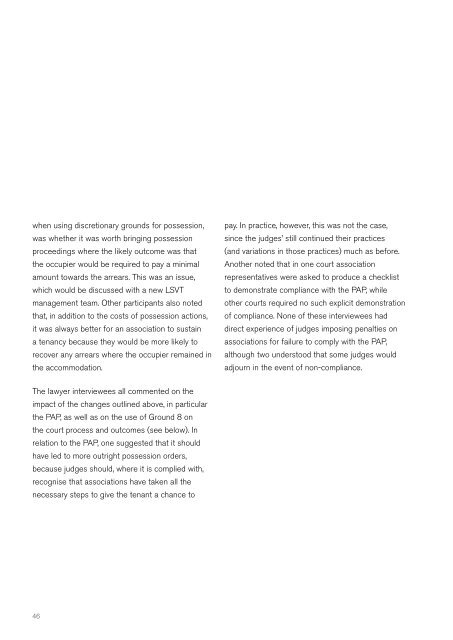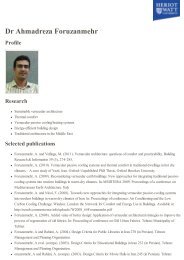Rent arrears management practices in the housing association sector
Rent arrears management practices in the housing association sector
Rent arrears management practices in the housing association sector
Create successful ePaper yourself
Turn your PDF publications into a flip-book with our unique Google optimized e-Paper software.
when us<strong>in</strong>g discretionary grounds for possession,<br />
was whe<strong>the</strong>r it was worth br<strong>in</strong>g<strong>in</strong>g possession<br />
proceed<strong>in</strong>gs where <strong>the</strong> likely outcome was that<br />
<strong>the</strong> occupier would be required to pay a m<strong>in</strong>imal<br />
amount towards <strong>the</strong> <strong>arrears</strong> . This was an issue,<br />
which would be discussed with a new LSVT<br />
<strong>management</strong> team . O<strong>the</strong>r participants also noted<br />
that, <strong>in</strong> addition to <strong>the</strong> costs of possession actions,<br />
it was always better for an <strong>association</strong> to susta<strong>in</strong><br />
a tenancy because <strong>the</strong>y would be more likely to<br />
recover any <strong>arrears</strong> where <strong>the</strong> occupier rema<strong>in</strong>ed <strong>in</strong><br />
<strong>the</strong> accommodation .<br />
The lawyer <strong>in</strong>terviewees all commented on <strong>the</strong><br />
impact of <strong>the</strong> changes outl<strong>in</strong>ed above, <strong>in</strong> particular<br />
<strong>the</strong> PAP, as well as on <strong>the</strong> use of Ground 8 on<br />
<strong>the</strong> court process and outcomes (see below) . In<br />
relation to <strong>the</strong> PAP, one suggested that it should<br />
have led to more outright possession orders,<br />
because judges should, where it is complied with,<br />
recognise that <strong>association</strong>s have taken all <strong>the</strong><br />
necessary steps to give <strong>the</strong> tenant a chance to<br />
46<br />
pay . In practice, however, this was not <strong>the</strong> case,<br />
s<strong>in</strong>ce <strong>the</strong> judges’ still cont<strong>in</strong>ued <strong>the</strong>ir <strong>practices</strong><br />
(and variations <strong>in</strong> those <strong>practices</strong>) much as before .<br />
Ano<strong>the</strong>r noted that <strong>in</strong> one court <strong>association</strong><br />
representatives were asked to produce a checklist<br />
to demonstrate compliance with <strong>the</strong> PAP, while<br />
o<strong>the</strong>r courts required no such explicit demonstration<br />
of compliance . None of <strong>the</strong>se <strong>in</strong>terviewees had<br />
direct experience of judges impos<strong>in</strong>g penalties on<br />
<strong>association</strong>s for failure to comply with <strong>the</strong> PAP,<br />
although two understood that some judges would<br />
adjourn <strong>in</strong> <strong>the</strong> event of non-compliance .




